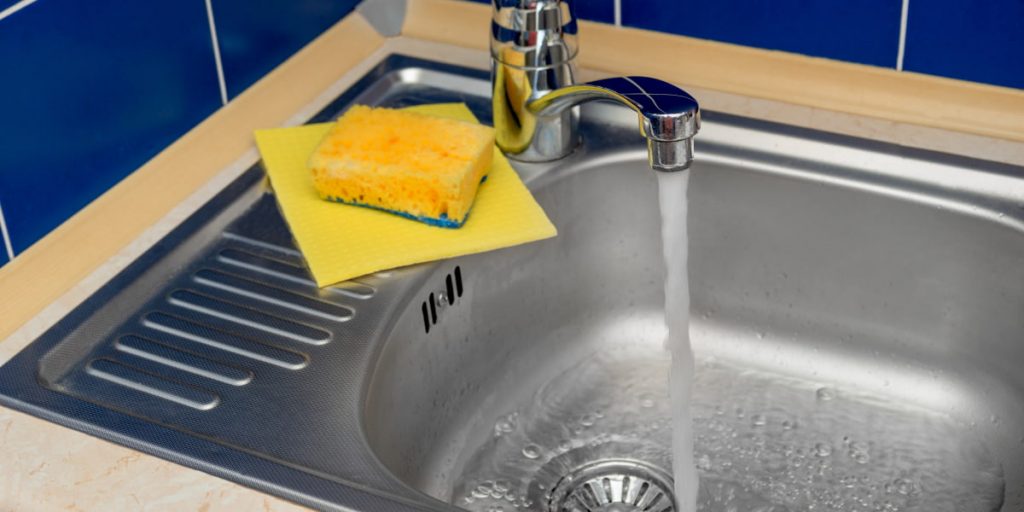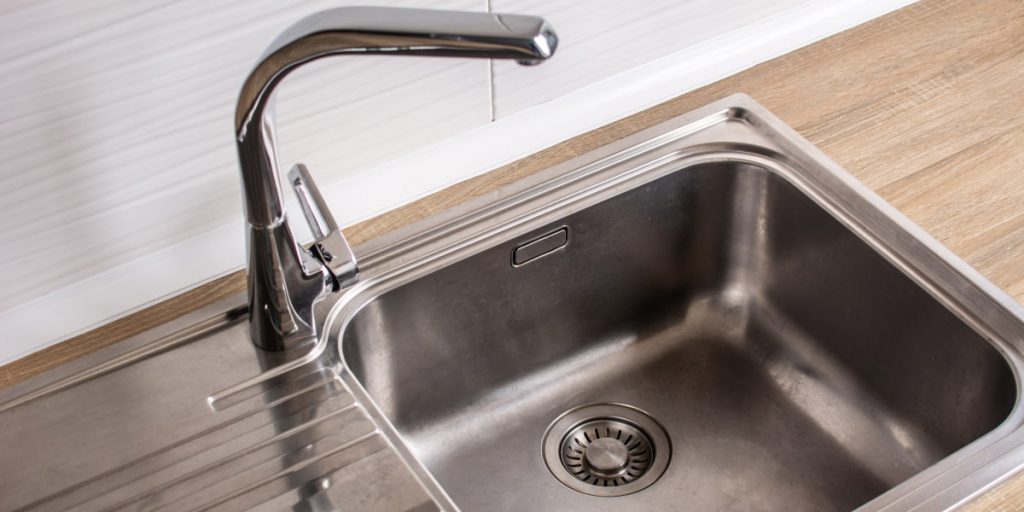Published on November 1st, 2022
Last updated on February 3rd, 2023
How To Remove Stains From Stainless Steel Sink?

Stainless steel is an extremely tough and resilient material. A stainless steel kitchen sink is visually appealing and, unlike an enamel sink, is resistant to scratches, stains, and other consequences of regular usage damaging to other sinks.
The chrome plating protects the sink against corrosion and tarnishing caused by limescale, black stains, and grease, but the sink’s surface can be affected by dirt and soot; therefore, stainless steel must be maintained clean.
Cleaning stains from stainless steel sinks can be a challenge. Depending on the type of stain, you can try several different methods.
This blog article will discuss some of the most common methods for cleaning stains from stainless steel sinks. We will also give some tips on daily maintenance. Let’s get started!
Cleaning of Stainless Steel Sinks

If your stainless steel sink tarnishes or has stubborn stains, you will need additional cleaning products.
Of course, you can opt for speciality chemical products, but cleaning them with folk remedies is just as effective. If used properly, they are safer than chemicals, cheap, and can be found anywhere.
Dark gray and black stains appear on the sink because of the oxidation of the protective film. Dullness is the result of exposure to moisture. Contact with cleaning agents that contain chlorine, iodine, or concentrated acid solutions (such as acetic or citric acid) can cause it. The following can help eliminate dark stains: baking soda, vinegar, potatoes, bleach and toothpaste. Let’s start step by step:
Baking Soda
Polishing stainless steel sinks and getting rid of ugly stains, it is not necessary to resort to the help of solid household chemicals. Baking soda, which you can find in every kitchen, can help.
Wet a sponge and apply the product on the abrasive side. Then scrub the trouble spots. Use an old toothbrush to access hard-to-reach areas. After the stains have been removed, rinse the baking soda with water and wipe the sink dry.
Vinegar
If your stainless steel sink has started to darken, but cleaning is necessary, regular table vinegar can help. Pour the solution onto a kitchen sponge and go over the dirty areas of the sink. Leave it on for 15 to 20 minutes. Then rinse the sink well with warm water and liquid detergent to eliminate the unpleasant smell of vinegar. Wipe until shiny.
Starch, Potato or Decoction
To cope with stains and plaque on the stainless steel sink will help potato starch, potato decoction or the root vegetable itself.
- If you opt for the first option, pour the starch on a damp sponge and clean the sink, previously doused with warm water.
- Pour the hot potato broth into the sink with the drain closed and wait for the liquid to cool. Then scrub the sink with a sponge or cloth.
- Cut raw potatoes into large pieces and rub them on dirty areas of the stainless steel sink.
Bleach
You can use a bleach-polish stainless steel sink. Put a small amount on a sponge and rub the dirty sink. Rinse immediately with water.
But first, we recommend you test it on a small sink area.
Toothpaste
Another cleaning agent that is always at hand is toothpaste. You can use it to remove minor scratches on the sink’s surface and make it shine.
Take a little toothpaste on a damp sponge or soft cloth and wipe the problem areas. Rinse well with water immediately after cleaning.
Daily Care

It’s better to prevent a problem than polishing stainless steel sink. It’s a truism that should be applied to your home as well. The best way to avoid time-consuming, multi-step cleaning of your sink is to take good care of it daily. It involves the following steps:
- Wash dirty dishes by completely emptying the bowl.
- Clean the drain hole of food debris and pull out the safety grid.
- With a soft sponge, apply dishwashing liquid or laundry soap to the bottom and walls of the sink.
- After 10 minutes, cleaning stainless steel sinks of grease and other contaminants with the hard side of a sponge. Be sure to wash the grid on both sides and the drain hole.
- Rinse off any remaining cleaning agent with hot water, then, as an additional disinfectant, pour boiling water over the bowl.
- After a few minutes, wipe dry with a cloth made of natural fibre (preferably cotton). The stainless steel sink can leave unsightly streaks if this is not done.
Giving a Shine to Your Stainless Steel Sink

After cleaning, your stainless steel sink should have a beautiful shine. But if it still lacks radiance, you can use one of the following methods:
- Salt Water
Make a cleaning solution combining one tablespoon of salt and two cups of hot water. Dip a sponge in the resulting mixture and rub the entire surface of the sink with circular motions. Rinse with clean water afterwards.
- Lemon
Cut a lemon in half and sprinkle salt on the juicy, fleshy side. Rub problem areas for 2-3 minutes. If necessary, leave for 10 minutes so that the acidic properties of lemon take effect. Then rinse the cleaning agent with plenty of water and dry the stainless steel sink with a cotton cloth or napkin.
- Olive Oil
This product will give your stainless steel sink a natural shine. To accomplish this, apply a small amount of olive oil to a clean cloth or sponge and rub the surface of the polishing stainless steel sinks. Wipe clean with a dry cloth or napkin.
Thank you for your consideration! You should now have the necessary tools and knowledge to clean your stainless steel sink rapidly, so get to work! If you find this material useful, please share it with others who may require assistance removing those pesky stains.
FAQ
How to remove stains from stainless steel sinks?
There are a few ways to remove stains from your stainless steel sink. You can use cleaning agents such as bleach, toothpaste, or olive oil.
Can I use vinegar to clean my stainless steel sink?
Yes, you can use vinegar to clean your stainless steel sink. Just mix one part vinegar with one part water and apply it to the surface of your sink and then wipe it clean.
Is it safe to use bleach on my stainless steel sink?
Yes, you can use bleach on your stainless steel sink. Just make sure to rinse it off afterwards with plenty of water. You should also avoid using bleach on stainless steel sinks that are cracked or chipped.


